Great Flying Boats of the Second World War By Chuck Hawks Obsolescent by the end of the War, long range maritime patrol flying boats (seaplanes) were nevertheless produced and used by most of the major WW II maritime powers. Their greatest advantage being that they could be deployed to sheltered coves over some 70% of the earth's surface and supplied from ships (seaplane tenders) without need for constructing an airfield. No airfield meant no battle with enemy troops for possession of the land, no supply line to sustain the airfield and this made the seaplane's "base" much harder to detect. As forward, long range reconnaissance aircraft, flying boats were ideal. They were also capable cargo and troop transports that did not require long, prepared runways and it is in this role that the later flying boats primarily served. Of course, all weapon systems have weaknesses and for seaplanes of any type these were primarily in the areas of performance. A land based airplane with retractable landing gear can be designed to be more aerodynamically efficient than a flying boat. Because it is more efficient in the air, it can be faster with the same propulsive power and it can have a longer cruising range. Greater efficiency also means that the aircraft can carry a greater load of cargo, bombs and/or guns with the same amount of fuel. Nautical equipment, including dingys, lines, winches, boat hooks, mooring gear and anchors, etc. need not be carried by land planes, increasing their useful payload. Twin and single-engined seaplanes were numerous and served in many roles, including reconnaissance, as fighters and shipboard scouts. Large, four-engined flying boats were technically complicated and comparatively expensive to manufacture. Consequently, they were far less common. However, they have a special fascination and grandeur all their own. For the Allied maritime powers, long range flying boats made a major contribution in the battle against the U-boats. They searched for U-boats on the high seas and provided critical anti-submarine protection for convoys. Flying boats also served as long range transports of valuable personnel and cargo and sometimes as rescue aircraft. With a plentitude of secure land bases around the perimeter of the North Atlantic, the primary venue of the U-boat battle, the introduction of maritime patrol versions of heavy bombers, especially the long range PB4Y (maritime patrol version of the B-24 Liberator), substantially reduced the importance of the maritime patrol flying boat in the later stages of the war. In the great reaches of the Pacific, where the possession of island airfields sparked fierce land battles that cost both sides dearly, the long range flying boat remained an important naval weapon until the final stage of the war. In the U.S., the development of the largest flying boat of them all, Howard Hughes' eight-engined Spruce Goose, continued until its first and only flight, well after the war had ended. Development of turbine powered seaplanes continued far into the Cold War era by the U.S., Japan, Red China and Russia. The latter three nations still operate seaplanes. Post-war seaplane developments are, however, beyond the scope of this article. This article will examine the greatest flying boats that saw
operational use during the war. It does not include amphibians or twin-engined
seaplanes, such as the fine PBY-5a Catalina, only multi-engined flying boats. Our
short list of great flying boats includes the Consolidated Vultee PB2Y Coronado
(United States), Martin JRM Mars (United States), Kawanishi Type 2 (Japan), Short
Sunderland (Great Britain), and Blohm & Voss 222 Viking (Germany). The
specifications for the great flying boats in this article were taken primarily from
Janes Fighting Aircraft of World War II,
supplemented by online data from Wikipedia. JAPAN  The Imperial Japanese Navy made extensive use of their long range flying boats in WW II. Their long range master was the Kawanishi H8K Type 2, a high performance, four-engined bomber, reconnaissance and transport aircraft code named "Emily" by the Allies. This was the best flying boat of the war with excellent performance, long range and good defensive armament. Emilys ranged the Pacific, providing valuable information about Allied movements and dispositions. They were also employed as long range bombers and Type 2 flying boats raided Honolulu, Hawaii in March 1942. Because of their long range, they were pressed into service as scouts for Japanese carrier striking forces, but they often suffered grievous losses at the hands of radar directed carrier-borne fighters when they approached U.S. task forces. Unlike most Japanese aircraft, the H8K-2 incorporated armor protection for the crew and protected fuel tanks in the wings and fuselage. Defensive armament included single 20mm cannon in the nose turret, dorsal turret, tail turret and (port and starboard) beam blisters. These were augmented by five .303 machine guns firing from hull hatches. Offensive weapons included two torpedoes or 2205 pounds of bombs and depth charges. Performance was excellent, the best of any of the big WW II flying boats. Top speed was almost 300 mph at around 20,000' and the service ceiling was over 28,000'. After the Japanese developed radar, surface search sets were fitted to H8K patrol bombers. The prototype H8K's first flight took place in January 1941 and the first production version was the H8K-1, Type 2, Model 11, which entered service early in 1942. 14 were completed before production shifted in 1942 to the definitive and considerably improved H8K-2, Type 2, Model 12. Improvements included up-rated engines, increased fuel capacity and a heavier defensive armament. 112 HK8-2's, the most numerous model, were built during WW II. Four survived the war and one of these was brought to the U.S. for evaluation after the war. This aircraft was returned to Japan in 1979 and can be seen today at the Kanoya Museum (Kanoya airfield), Kagoshima. There was a transport version of the H8K, the H8K-2L, and 36 of these were built. Most of the defensive armament, including the side blisters and dorsal turret, was suppressed to increase the weight of troops and material it could carry. The fuselage fuel tanks were removed to increase its cargo volume. The result of these modifications was that the H8K-2L could transport up to 62 combat troops. One of the important Japanese strategic oversights of the war was their failure to protect their merchant shipping. It is my opinion that far more extensive use should have been made of flying boats to protect the valuable convoys bringing raw materials to Japan from her far-flung conquered territories. American submarines sank about half of the entire Japanese merchant fleet with little interference from the air, yet air cover proved to be the most effective submarine deterrent of the war. The importance of the offensive operations that resulted in the destruction of Kawanishi flying boats at the hands of U.S. fighters pales in comparison to the service these aircraft could have performed protecting convoys from submarine attack. The traditional Japanese offensive spirit cost them dearly during the war. Following are some specifications for the H8K2 Type 2 flying boat, Model 12.
GERMANY 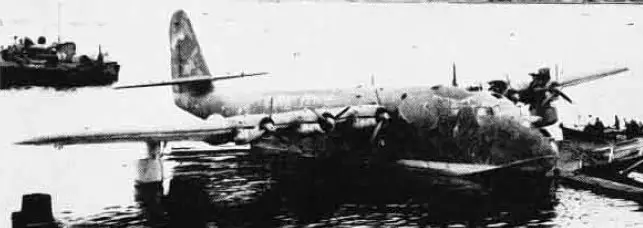 Ship builder Blohm & Voss built a couple of large flying boat transport aircraft for Germany during the war. The huge (220,460 pound max. take off weight), six-engined, Bv-238 did not reach production or operational service before the war ended and only one prototype was ever built. It was destroyed while tied to its dock at Schaal Lake in September 1944 by three P-51 fighters. Bv 222 Viking, first flew in September 1940 and the first Bv 222 (aircraft V1) accepted by the Luftwaffe was carrying supplies and personnel between Hamburg and Norway in 1941. By the Fall of 1941, the Bv 222 was operating in the Mediterranean theatre, ferrying supplies to the Afrika Corps. During the course of the war, Bv 222's operated in diverse theatres, from Africa to the Arctic. As a troop transport, the Bv 222 could transport up to 92 passengers or 72 wounded men on stretchers. The Viking was based on the design of a trans-Atlantic civil airliner being developed before the war for Lufthansa and the type was carried forward as a large military transport. The Bv 222 became the largest aircraft to shoot down an enemy airplane during the war, when a Bv 222 (V4) shot down a PB4Y (B-24) patrol plane. Only 13 Bv 222's were built. The early Vikings (aircraft V1 through V6) were powered by six Bramo 323 nine-cylinder radial engines. V7 became the prototype for later production and was fitted with six Junkers Jumo 207C twelve-cylinder opposed diesel engines, and apparently so was V8. Later production aircraft (designated C9 through C12) were also powered by Jumo diesel engines. C13 was fitted with Jumo 205C and later Jumo 205D engines. From the end of 1941 onward, Bv 222's were armed for self-defense. This originally included a 13mm machine gun in a forward top turret located behind the control cabin, a 13mm machine gun in an aft dorsal turret, four lateral firing 8mm machine guns (two/side) in waist mounts and an 8mm nose gun. In aircraft V2 this was augmented by turrets mounted on the upper surface of each wing aft of the outboard engines, each carrying a pair of 13mm machine guns. An alternative and presumably later armament scheme was reported to be three 20mm cannons (one each in the forward top turret and the wing turrets, the aft dorsal turret having been deleted) plus five 13mm machine guns (one in the nose and two/side). The Bv 222 could haul its crew of 11 and 92 troops and their supplies on its two decks. Most freight and the majority of troops were carried on the lower (cargo) deck. Fuel was carried in a huge tubular wing spar, variously described as being either 39" or 57" in diameter, that extended from wing to wing through the fuselage. The center section of this wing spar was subdivided by bulkheads into fuel tanks. A passageway in the wings gave access to the engines during flight an also to the wing mounted machine gun turrets that were fitted to V2 and later aircraft. Because so few Bv 222's were built, each was practically a custom built airplane and the specifications varied. Four Bv 222's were captured by the Allies at the end of the war. One (C12) was flown from Norway to the UK, where it was tested, put into operation and eventually scrapped. V2 was also captured in Norway and eventually scuttled by the British to dispose of her. Two (C11 and C13) were taken by the U.S. for testing and later presumably scrapped, although their precise fate is uncertain. None survives today, although there are plans to raise V2 for restoration. Here are some specifications for the Bv-222.
GREAT BRITAIN 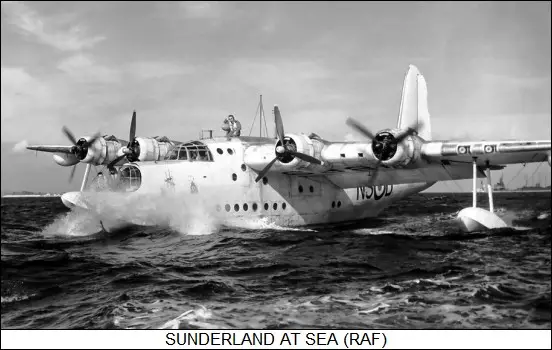 The most famous, as well as the most important, British flying boat of the war was undoubtedly the Short S-25 Sunderland, which first flew in 1937. This four-engine RAF reconnaissance and maritime patrol flying boat was essentially the military version of the Short Empire civil transport. It was the first flying boat to be equipped with power operated gun turrets and was produced in four successive variations, the Mk. I, II, III and V. (The Mk. IV Sunderland was developed into the improved Seaford flying boat.) Typical defensive armament of the Sunderland V was 8-.303 machine guns arranged in a twin turret in the nose, a dorsal twin turret and a quad tail turret. Provision was made for the installation of four fixed .303 machine guns in the nose and two beam .303 machine guns. Disposable ordinance included bombs, depth charges and mines. There was a bombardier's position in the nose. The Mk. V's performance was improved over previous models by substituting 1200 hp Pratt & Whitney Twin Wasp radial engines with improved propellers for the underpowered Pegasus engines. This was a very satisfactory change, for while performance was increased, range and endurance remained about the same. Sunderlands were fitted with airborne surface search radar early on, starting with the Mk. I. Their radar was continually upgraded as the war went on and later models had increasingly sophisticated installations that made them very effective submarine hunters. 749 Sunderlands were completed before production ceased in 1946. Sunderlands served in the RAF in the Far East until 1959 and with the Royal New Zealand Air Force until 1967. The type also served with the Australian Air Force, Canadian Air Force, South African Air Force, Norwegian Air Force, Portuguese Navy and the French Navy. After the war, converted Sunderland flying boats were operated by a number of civilian air lines. Following are some specifications for the Sunderland III, the most numerous model with some 467 completed.
UNITED STATES 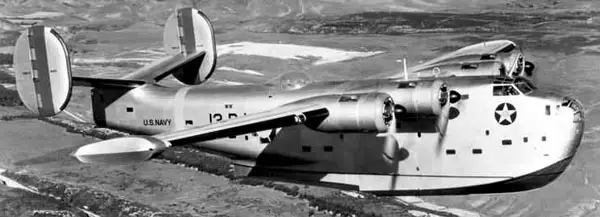 Consolidated Vultee's PB2Y Coronado flying boat was a successful four-engined patrol bomber, transport and flying naval ambulance first ordered by the U.S. Navy in 1936 as the successor to the obsolescent PBY Catalina. In the event, both types served throughout the war. The PB2Y-2, the first production version, entered service in January 1941. The PB2Y-3 was produced from late 1941 until 1944 and incorporated self-sealing fuel tanks and improved armor protection for the crew. In 1944, production shifted to the PB2Y-5 using Pratt & Whitney R-1830-92 radial engines with single stage superchargers, the same engine used in the Catalina flying boat. This change saved weight, increased load capacity and did not impede their low altitude performance, although it degraded their high altitude performance. However, PB2Y's did not usually operate at high altitude. The transport versions were the PB2Y-3R and PB2Y-5R (44 passengers or 16,000 pounds of cargo) and most PB2Y-3 patrol bombers were eventually converted to -3R standard. The PB2Y-5H flying ambulance version could accommodate up to 25 stretcher cases. In the Pacific, PB2Y-3R's (and later -5R's) were a crucial part of the Naval Air Transport Service fleet. Most had originally been built as -3 patrol bombers, but their limited combat radius relegated them to transport service. By 1945, the Coronado was showing its age and soon after the end of the war the Coronado fleet was retired. Only one Coronado survives today, the others having been scraped after the war. The Coronado was the USN's most successful four-engined flying boat, built in much greater numbers than the larger (145,000 pound max TO weight) Martin JRM-1 Mars transport, of which only seven were completed. The first production Mars did not enter service until the summer of 1945, while the Coronado served throughout the war. Among Allied flying boats, the Coronado was very competitive with the more famous Sunderland flying boat, except in range. (The earlier, smaller and less expensive PBY Catalina handily outranged the Coronado, which was the key to the Catalina's longevity.) Here are the specifications for the PB2Y-3 Coronado patrol bomber.
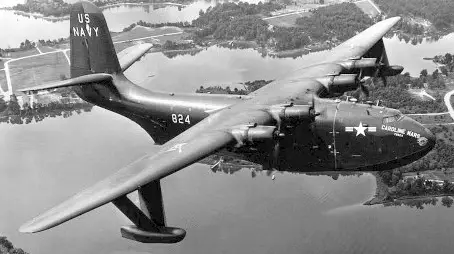 The Martin JRM Mars was the largest Allied flying boat of World War II. It earned its place in this article by being the only WW II era flying boat still operating (in a civilian capacity), despite its very low total of seven aircraft (two prototypes and five production JRM's). The prototype Mars ("Old Lady") was ordered by the U.S. Navy as the XPB2M-1 in 1938, as a long range patrol bomber. This flying boat originally flew with a twin vertical stabilizer tail, which was later converted to a more conventional single vertical stabilizer tail; she was scrapped in 1945. However, by the time the project was nearing fruition, flying boat patrol bombers were becoming obsolete and subsequent Mars aircraft were re-designated as JRM-1 transports. (The surviving JRM-1's were eventually upgraded and re-designated JRM-3.) The Hawaii Mars (apparently the second prototype, later accepted for active service) did not enter service with the USN until June 1945. Hawaii Mars served delivering troops and supplies from San Francisco to Hawaii and this was to become the primary Navy role for all of the Mars aircraft until they were retired in 1956. The first Hawaii Mars crashed on Chesapeake Bay and the name was reassigned to one of the five production aircraft, the last of which, Caroline Mars, completed in 1947, was furnished with 3000 hp Pratt & Whitney R4360 radial engines. This aircraft was designated JRM-2 and subsequent Mars aircraft would have been completed to her standard, had they been built. The extra power allowed a 20,000 pound increase in gross take off weight. The Navy initially ordered 20 production Mars flying boats, but the end of the war caused that contract to be cancelled and only the five under construction at the time were accepted and entered service. The Martin JRM-1 Mars transport was a very large flying boat, substantially larger than the Bv 222. These flying boats were so distinctive that each of the five production planes were given names, like ships: Hawaii Mars II, Philippine Mars, Marshall Mars and Caroline Mars. In June 1950, the Marshall Mars burned on the water at Hawaii and sank due to an engine fire. After being retired by the Navy in 1956 and listed for disposal in 1959, the four remaining Mars aircraft were purchased by a Canadian company, Flying Tankers, Inc., and converted for arial fire fighting as water bombers. They performed very well in this role and I actually saw one of them on Sproat Lake near Port Alberni (Vancouver Island), BC on a motorcycle trip to Canada in the late 1970's. The Marianas Mars crashed in Canada while fire fighting in 1961 and the Caroline Mars was destroyed on the ground at Victoria, BC by typhoon Freda in October 1962. The surviving pair, Hawaii Mars II and Philippine Mars, are now owned by the Coulson Group and are based at Port Alberni, BC. They remain active as fire fighters. Philippine Mars has been extensively refitted, 2007-2010. They have been used up and down the Pacific region of Canada and the USA and fought many famous fires, including the California wildfires of 2007 and the La Brea wildfire in Southern California in 2009. They have proven capable of dropping 7200 gallons of water on a fire every 15 minutes when operating near a lake. Here are some specifications for the Navy's JRM-1/JRM-3.
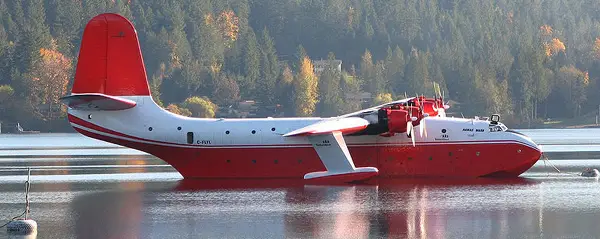 |